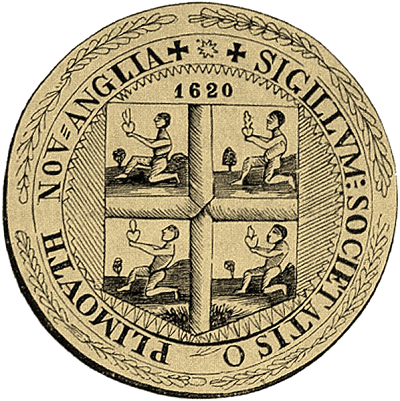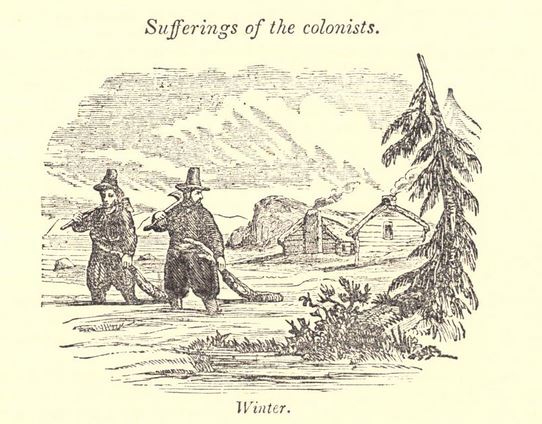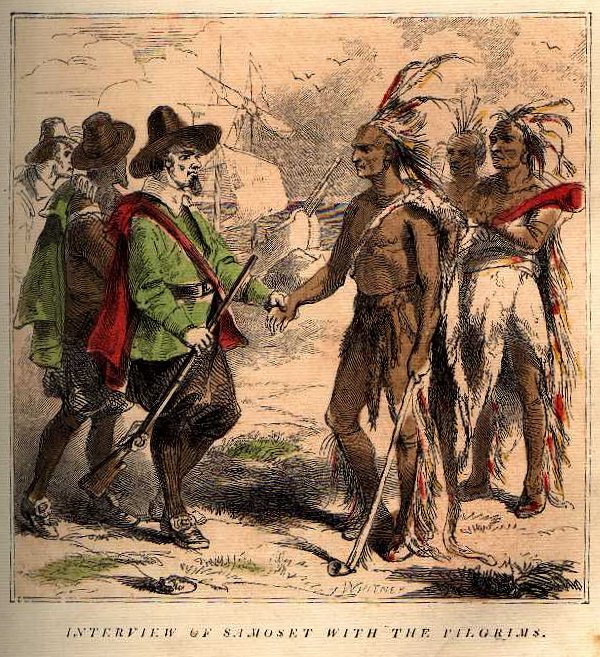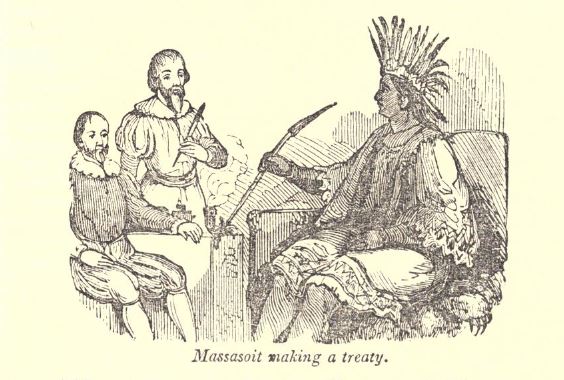Plymouth Colony was a British colony in Massachusetts in the 17th century and was the first permanent colony in Massachusetts and the first colony in New England.
The following are some facts about Plymouth Colony:
Who Founded Plymouth Colony?
Plymouth colony was founded by the Plymouth Company during the Great Puritan Migration.
The Plymouth Company was a joint stock company founded in 1606 by King James I with the goal of establishing settlements along the east coast of North America.
Who Settled Plymouth Colony?
The Plymouth Company, which consisted of 70 investors, had an agreement with the settlers of the Plymouth Colony, the pilgrims, promising to finance their trip to North America and in return the settlers would repay the company from profits made by harvesting supplies, such as timber, fur and fish, which were then sent back to England to be sold.
Most of the pilgrims were from farming communities in Yorkshire, England but moved to Leiden, Holland in 1607 seeking religious freedom.
They found the religious freedom they were looking for there but they also found it hard for them to retain their English identity in a Dutch country and it was also hard for them to make a living there.
The pilgrims worked primarily in the cloth trade in Holland but the hours were long and grueling and were having a negative impact on the pilgrims’ health. They were desperate to emigrate to North America and sought out the investors to help fund their trip in 1619.
Since the pilgrims didn’t have enough people to join and help them build the colony, the investors recruited outsiders to join. These outsiders were not separatists and held different religious beliefs.

Plymouth Colony seal circa 1629
The Mayflower Voyage:
The pilgrims traveled to North America on a rented cargo ship called the Mayflower. The ship left Plymouth, England in September of 1620 and finally landed off the coast of Massachusetts in November.
The colonists were originally headed for Virginia, where they had a land patent to settle the area, but had drifted off course during the sea voyage and made landfall just as they ran out of supplies.
Although they didn’t have official permission to settle in what is now modern day Massachusetts, they decided to stay and settle the area anyway because they had run out of supplies and winter was setting in.
The pilgrims first landed at what is now modern day Provincetown. After some skirmishes with the local Native-American tribe there, the pilgrims decided to sail to nearby Plymouth.

“First sight of the Indians.” Illustration published in A Pictorial History of the United States circa 1852
When the pilgrims arrived they landed at an abandoned Native-American village, called Patuxet, whose inhabitants had died in the infamous disease epidemic of 1616-1618.

“The landing.” Illustration published in A Pictorial History of the United States circa 1852
There they found abundant cornfields planted by the Patuxet years ago and many areas, which had already been cleared by the Patuxet, where they could build their homes.
How Many Pilgrims Died the First Winter?
When the pilgrims landed in Plymouth, many of them were already weak from disease and a lack of food. The voyage had been long and they were short on supplies.
Over the course of the winter, the colony lost almost half of its people due to disease and starvation. In his diary, which was later published under the title Of Plymouth Plantation, Bradford refers to this period as the “Starving Time”:
“But that what was most sad and lamentable was, that in two or three months’ time half of their company died, especially in January and February, being the depth of the winter, and wanting houses and other comforts; being infected with the scurvy and other diseases which this long voyage and their inaccommodate condition had brought upon them. So there died some times two or three of a day in the foresaid time, that of 100 and odd persons, scarce fifty remained.”

“Suffering of the colonists. Winter.” Illustration published in A Pictorial History of the United States circa 1852
About 50 of the 102 Mayflower passengers died over the course of the sea voyage and the first winter of 1620/21:
John Allerton, Mayflower crewmen, died sometime during the winter
Mary (Norris) Allerton, separatist and wife of Isaac Allerton, died February 25, 1621
Dorothy (May) Bradford, separatist and wife of William Bradford, drowned after she fell overboard at Provincetown Harbor on December 7, 1620
William Butten, servant, died November 6, 1620 on board the Mayflower
Richard Bitterridge, non-separatist, died December 21, 1620
Robert Carter, servant, died sometime during the winter
Richard Clarke, non-separatist, died sometime during the winter
James Chilton, separatist, died December 8, 1620
Mrs. James Chilton (first name unknown), separatist and wife of James Chilton, died sometime during the winter
John Crackstone, separatist, died sometime during the winter
Sarah Eaton, non-separatist and wife of Francis Eaton, died sometime during the winter
Thomas English, Mayflower crewmen, died sometime before the Mayflower returned to England in April 1621
Moses Fletcher, separatist, died sometime during the winter
Edward Fuller, separatist, died sometime during the winter
Mrs. Edward Fuller, separatist and wife of Edward Fuller, died sometime during the winter
John Goodman, separatist, died sometime during the winter
John Hooke, servant, died sometime during the winter
William Holbeck, servant, died sometime during the winter
John Langmore, servant, died sometime during the winter
Edmund Margesson, non-separatist, died sometime during the winter
Christopher Martin, non-separatist, died January 8, 1621
Mary (Prower) Martin, non-separatist and wife of Christopher Martin, died sometime during the winter
Ellen More, servant, died of illness in November of 1620
Jasper More, servant, died of illness on December 6, 1620
Mary More, servant, died sometime during the winter
William Mullins, non-separatist, died February 21, 1621
Alice Mullins, non-separatist and wife of William Mullins, died sometime during the winter
Joseph Mullins, son of William and Alice Mullins, died sometime during the winter
Solomon Prower, non-separatist, died December 24, 1620
Degory Priest, separatist, died January 1, 1621
John Rigsdale, non-separatist, died sometime during the winter
Alice Rigsdale, non-separatist and wife of John Ringsdale, died sometime during the winter
Thomas Rogers, separatist, died sometime during the winter
Elias Story, a person in the care of Edward Winslow, died sometime during the winter
Edward Tilley, separatist, died sometime during the winter
Ann (Cooper) Tilley, separatist and wife of Edward Tilley, died sometime during the winter
John Tilley, separatist, died sometime during the winter
Joan (Hurst) (Rogers) Tilley, separatist and wife of John Tilley, died sometime during the winter
Thomas Tinker, separatist, died sometime during the winter
Mrs. Thomas Tinker, separatists and wife of Thomas Tinker, died sometime during the winter
Son of Thomas Tinker (name unknown), died sometime during the winter
Edward Thompson, servant, died December 4, 1620
John Turner, separatist, died sometime during the winter
Both sons of John Turner (names unknown), died during the winter
William White, separatist, died February 21, 1621
Thomas Williams, separatist, died sometime during the winter
Roger Wilder, died sometime during the winter
Elizabeth (Barker) Winslow, separatist and wife of Edward Winslow, died March 24, 1621
Rose Standish, separatist and wife of Miles Standish, died January 29, 1621
Two more people, Governor John Carver and his wife Katherine, died in the spring and summer of that year.
Historians believe that most of the colonists were suffering from diseases and illnesses such as scurvy, which is caused by a lack of vitamin c found in many fruits and vegetables, and pneumonia, which was probably caused by the damp, cold weather. In addition, the lack of food made them weak and more susceptible to disease.
Bradford describes how seven of the colonists cared for the sick at great risk to their own health by fetching them wood, dressing and feeding them, washing their clothes and etc. Bradford identified two of these kindhearted people as Reverend William Brewster and Miles Standish.
Yet he also described many people, whom Bradford implied were either crewmen or non-separatists, who turned on each other as the sickness spread and began cursing each other for their bad fortune and refusing to help the ill, stating “if they died, let them die.”
Another settler Phineas Pratt, who arrived in Plymouth in 1623, later told a disturbing story about what had been done with the sick men in the colony that winter.
Pratt testified in a court deposition in 1662 that the pilgrims told him they had dragged their sick men into the woods and propped them up against trees to serve as a decoy defense system against the Native-Americans:
“We asked them where the rest of our friends were that came in the first ship [the Mayflower.] They said that God had taken them away by death, and that before the second ship came, they were so distressed with sickness that they, fearing the savages should know it, had set up their sick men with their muskets upon their rests and their backs leaning against trees.”
Bradford doesn’t confirm this story in his diary, stating instead that the sick were cared for in their cabins but does acknowledge that the sick were later sent ashore by the crew and made to drink water so that the crew members could save the beer for themselves:
“As this calamity fell among the passengers that were to be left here to plant, and were hasted ashore and made to drink water that the seamen might have more beer, and one in his sickness [who was the author, Bradford, himself] desiring but a small can of beer, it was answered that if he were their own father he should have none. The disease began to fall amongst them also, so as almost half of their company died before they went away, and many of their officers and lustier men, as the boatswain, gunner, three quartermasters, the cook and others. At which the Master was something strucken and and sent to the sick ashore and told the Governor he should send for beer for them that had need of it, though he drunk water homeward bound.”
It is not know where the colonists who had died during the first year are buried but it is believed they were buried in unmarked graves in Cole’s Hill Burial Ground in Plymouth.
Historians think the reason they were buried in unmarked graves was to avoid letting the local Native-Americans know how many of them had died and to avoid having their graves disturbed.
On April 5, 1621, the Mayflower and her crew departed Plymouth and returned to England. The ship was supposed to bring back goods that the colonists had harvested but returned empty due to the colonist’s poor health that winter.
Squanto and the Wampanoag:
While the pilgrims were sick that winter, Bradford states that a number of Indians often appeared nearby but ran away whenever the pilgrims tried to approach them and even once stole the pilgrims’ tools from their work site while they were away eating lunch.
Around March 16, Bradford says that an Indian approached them and spoke to them in broken English, which amazed the pilgrims. The Indian identified himself as Samoset and told them much about the native people of the area and said there was another Indian named Squanto who had been to England and could speak better English them himself.

Interview of Samoset with the Pilgrims, illustration, circa 1864
After a while, Samoset returned for another visit and brought five more Indians with him and also brought back the tools that had been stolen from the pilgrim’s work site.
Samoset arranged for the pilgrims to meet their leader, Massasoit, who arrived about four or five days later with Squanto and many others accompanying him.
Squanto was the sole survivor of the Patuxet tribe and had only survived the disease epidemic that wiped out his tribe because he had been captured by an English sea captain a few years earlier in 1614 and had been taken to Europe as a slave.
He returned a few years later in 1619 with an English explorer to find his village wiped out. Squanto then came across Massasoit and the Pokanoket tribe, which, like the Patuxet, were one of many tribes that made up the Wampanoag Nation, and they made Squanto their slave.
Massasoit explained to the pilgrims that his tribe had been fighting with a powerful tribe nearby, the Narragansett, and needed their help.

“Massasoit making a treaty.” Illustration published in A Pictorial History of the United States circa 1852
Massasoit proposed a peace treaty and an alliance with the pilgrims. Bradford stated that the terms of the treaty, which is now known as the Pilgrim-Wampanoag Peace Treaty, were:
1. That neither he nor any of his, should injure or do hurt to any of their people.
2. That if any of his did any hurt to any of theirs, he should send the offender that they might punish him.
3. That if any thing were taken away from any of theirs, he should cause it to be restored; and they should do the like to his.
4. That if any did unjustly war against him, they would aid him; and if any did war against them, he should aid them.
5. That he should send to his neighbors confederates to certify them of this, that they might not wrong them, but might be likewise comprised in the conditions of peace.
6. That when their men came to them, they should leave their bows and arrows behind them.
In exchange for the pilgrim’s military help, Massassoit offered to help the pilgrims and teach them how to grow food and catch enough fish to feed the colony. The pilgrims agreed to the peace treaty and Massassoit ordered Squanto to teach the colonists everything they needed to know to survive.
The treaty was signed on April 1, 1621 and was honored for over 50 years.
The First Thanksgiving:
Squanto taught the colonists three important skills: how to grow corn, how to catch fish and where to gather nuts and berries. The colonists listened to Squanto’s instructions intently and applied everything they learned.
As a result, over the course of the spring and summer, the pilgrims were able to grow enough food to help them survive the coming winter.
To celebrate their successful harvest and to thank the Wampanoag for their help, the pilgrims held a harvest celebration sometime in the fall of 1621 and invited 90 Wampanoag, including Squanto and Massasoit, to the celebration. This event later came to be known as the first Thanksgiving.
The feast took place over the span of three days, during which the pilgrims and the Wampanoag ate food, such as venison and fowl, and played games.
The exact date of the celebration is not known and aside from venison and fowl, it is not known exactly what type of food was served at the celebration. Most historians assume that the colonists and Wampanoag ate whatever food was available at that time of year which would have been fish, lobster, mussels, fruit and wild game.
Harvest celebrations like these were common at the time among Europeans as well as among the Native-Americans. In fact, they occurred in most agricultural-based communities at that time.
The Wampanoags had traditionally held annual celebrations for the first harvest of the season, strawberries, with a “strawberry thanksgiving” celebration and the Algonquians had often held annual ceremonies linked to the crop cycle.
It is also not known if the celebration in 1621 became an annual event for the pilgrims and the Wampanoags but it eventually became a New England tradition, and was renamed Thanksgiving before Abraham Lincoln officially made it a national holiday in the 19th century.
The Economy of Plymouth Colony
The economy of Plymouth Colony was based on fish, timber, fur and agriculture. The colonists harvested trees for lumber, hunted beaver and otter for their pelts and fished for cod as well as hunted whales for their oil. They sent back all of the goods they harvested on ships and the Plymouth Company would sell the goods in England for a profit.
The colonists struggled for many years to make any money and were deeply in debt to their investors, the Plymouth Company, who had paid for the voyage and the start up money for the colony.
The colonists eventually bought out the investors when they became unhappy with the lack of return they saw from their investment.
The colony never became as economically successful as the nearby Massachusetts Bay Colony and was later merged with the Massachusetts Bay Colony in 1691.
The Government of Plymouth Colony
The government of Plymouth Colony originally ran as a charter government, even though they didn’t officially have a charter from the British government. A charter was official permission from the crown to establish a colony. It granted the colony the legal right to exist there and allowed it to establish a local government as long at the colony’s laws didn’t contradict the laws of England.
The only permission that Plymouth colony had to establish itself in North America was a land patent issued by the New England Council in 1621. This land patent did not give the colony the legal right to pass and establish laws in the colony.
Plymouth colony tried for many decades to obtain a charter from the British government but never succeeded. It eventually lost the right to self-govern entirely when it was merged with the Massachusetts Bay Colony in 1691 and became a royal colony known as the Province of Massachusetts Bay.
Religion in Plymouth Colony
Both the pilgrims who settled Plymouth Colony and the colonists who settled Massachusetts Bay Colony were puritans.
The difference was that the pilgrims were a sect within the puritan movement that had essentially given up on the idea that the Church of England could be reformed and wanted to completely separate from it.
The non-separatist puritans believed the Church of England could still be reformed and wanted to remain within the church to help improve it.
Essentially, the pilgrims were religious extremists and dissenters. There was no separation between the Church and the State in England at the time so the notion of wanting to separate from the church was considered treason and this made the pilgrims’ existence in England very dangerous.
This prompted them to leave England in 1607 and move to Holland. The colonists had a hard time making a living in Holland so they emigrated to North America in 1620 in the hope of both making money there and finding the isolation and privacy they desired to worship freely.
Government and religion in Plymouth Colony were intertwined and this only became more so as the colonists began passing more religious-based laws over the years.
Did the Plymouth Colonists Really Call Themselves Pilgrims?
The name “pilgrims” was applied to the colonists starting in the late 1700s after excerpts of William Bradford’s diary, Of Plymouth Plantation, was printed in Nathaniel Morton’s book New England’s Memorial in 1669.
In one of the excerpts, Bradford compares the colonists to pilgrims when describing their emotional last church service before they left Holland for the New World, stating that their pastor Reverend John Robinson:
“spent a good part of the day very profitably and suitable to their present occasion; the rest of the time was spent pouring out prayers to the Lord with great fervency, mixed with abundance of tears. And the time being come that they must depart, they were accompanied with most of their brethren out of the city, unto a town sundry miles off called Delftshaven, where the ship lay ready to receive them. So they left that goodly and pleasant city which had been their resting place near twelve years; but they knew they were pilgrims, and looked not much on those things, but lift up their eyes to the heavens, their dearest country, and quieted their spirits.”
If you want to visit the many sites in Plymouth that the pilgrims frequented, check out the following article Plymouth historic sites.
To see a timeline of Plymouth Colony, check out the following article Plymouth Colony Timeline.
Sources:
Bradford, William. History of Plymouth Plantation. Edited by Charles Deane, Privately Printed, 1856.
Norton, Mary Beth and Carol Sheriff, David W. Blight, Howard Chudacoff, Fredrik Logevall. A People and a Nation: A History of the United States, Brief Edition. Cenage Learning, 2015 .
Erickson, Paul. Daily Life in the Pilgrim Colony 1636. Clarion Books, 2001.
Morse, Jedidiah. The American Universal Geography. Thomas & Andrews, 1812.
Krusell, Cynthia Hagar. Plymouth Colony to Plymouth County. Pondside Publishing, 2010.
Wilkins, Mira. The History of Foreign Investment in the United States to 1914. Harvard University Press, 1989.
King, H. Roger. Cape Cod and Plymouth Colony in the Seventeenth Century. University Press of America, 2014.
Stratton, Eugene Aubrey. Plymouth Colony, Its History & People, 1620-1691. Ancestry Publishing, 1986.
McKenzie, Robert Tracy. “Five Myths About the Pilgrims.” Washington Post, 23 Nov. 2013,
www.washingtonpost.com/opinions/five-myths-about-the-pilgrims/2013/11/22/9f93e822-52c1-11e3-9e2c-e1d01116fd98_story.html?utm_term=.40533887956f
“Faith of the Pilgrims.” Plimoth Plantation, www.plimoth.org/what-see-do/17th-century-english-village/faith-pilgrims
Johnson, Madeline. “The Pilgrims Should Have Been Thankful for a Spirochete.” Slate, 20 Nov. 2012,
www.slate.com/articles/health_and_science/medical_examiner/2012/11/leptospirosis_and_pilgrims_the_wampanoag_may_have_been_killed_off_by_an.html
“Plymouth Colony.” History.com, A&E Television Networks LLC, www.history.com/topics/plymouth
“Religious Controversies in Plymouth Colony.” Pilgrim Hall Museum, www.pilgrimhallmuseum.org/pdf/Religious_Controversies_Plymouth_Colony.pdf
“The Plymouth Colony Archive Project.” Historical Archaeology and Public Engagement, University of Illinois, www.histarch.illinois.edu/plymouth/ccflaw.html
“Mayflower and Mayflower Compact.” Plimoth Plantation, www.plimoth.org/learn/just-kids/homework-help/mayflower-and-mayflower-compact
“Why the Pilgrims Abandoned Communism.” Free Republic, 22 Nov. 2004, www.freerepublic.com/focus/f-news/1285981/posts
Bower, Jerry. “Occupy Plymouth Colony: How a Failed Commune Led to Thanksgiving.” Forbes, 23 Nov. 2011, www.forbes.com/sites/jerrybowyer/2011/11/23/occupy-plymouth-colony-how-a-failed-commune-led-to-thanksgiving/#192076afbcd1
McIntyre, Ruth A. “What You Didn’t Know About the Pilgrims: They Had Massive Debt.” PBS.org, Public Broadcast Service, 26 Nov. 2015, www.pbs.org/newshour/making-sense/what-you-didnt-know-about-the-pilgrims-they-had-massive-debt/
“Were Pilgrims America’s Original Economic Migrants?.” PBS.org, Public Broadcast Service, 26 Nov. 2015, www.pbs.org/newshour/bb/were-pilgrims-americas-original-economic-migrants/
“The Pilgrims and the Fur Trade.” Pilgrim Hall Museum, www.pilgrimhallmuseum.org/pdf/The_Pilgrims_Fur_Trade.pdf

very good facts and website
I know right..
“The colonists were originally headed for Virginia, where they had a land patent to settle the area,” You might clarify that what was called “Virginia” in 1620 differs significantly from today. The colonists were heading to the mouth of the Hudson river, in present day New York.
Wow this really helped with my homework I appreciate it a lot this really helped me understand more about this so thank you.
HI this really helped thanks 😀
real good
I used this website so much for a project. It had lots of information I needed. Thanks!
Thank you this will be very helpful for my HW
best website ever